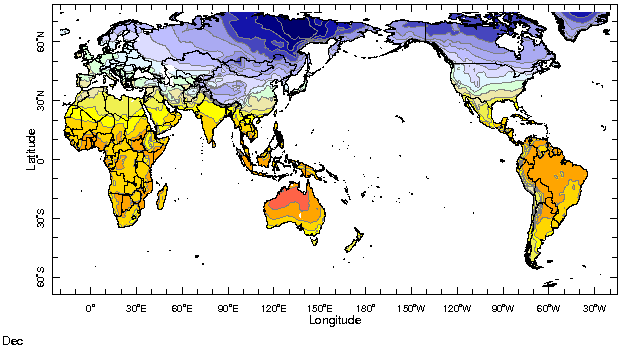|
IRI Climate Digest
January 2004
December Global Climate Summary
Climatological Background
In December, the Northern Hemisphere enters the heart of winter, with strong north-south temperature differences driving the mid-latitude jet stream and storm systems. In the Southern Hemisphere summer is under way, with monsoon systems gaining strength in South America, southern Africa, and Australia.
Monthly Mean Temperature (1961-1990), data from the Climate Research
Unit, University of East Anglia


Monthly Mean Precipitation (1961-1990), data from the Climate Research
Unit, University of East Anglia


Temperatures
Highlights
Africa: Although air temperatures remained above normal in much of West and Southern Africa, they returned to near-normal conditions in the Greater Horn and much of North Africa in December.
Europe: In December, temperatures were near-normal to slightly above-average in most of Western Europe, but increased to as high as 2°C to 4°C (3.6°F to 7.2°F) above normal northeastward into Scandinavia and western Russia. Places in northern Italy experienced temperatures at least 2°C (3.6°F) above normal, whereas parts of Romania and western Turkey had slightly cooler-than-normal conditions.
Asia: With the exception of some areas of northern India (which experienced a cold wave in late December), southern China, eastern Kazakhstan, and northeastern Russia, the majority of the Asian landmass experienced above-average temperatures in December. The largest departures, some exceeding 6°C or 7°C (10.8°F or 12.6°F) above normal, were found across western and central Russia. This was a large change from the previous month when areas in Siberia experienced negative temperature departures of -3°C or -4°C (-5.4°F or -7.2°F).
Australia: Although a few locations in central Australia were cooler than normal in December, average temperatures for the month were generally near-normal to slightly above-normal. The largest temperature departures from normal were found in eastern Australia.
South America: The cooler-than-normal temperatures in Uruguay and most of Argentina (influenced by the cool temperatures in the surrounding ocean waters) were the most notable temperature departures on the South American continent in December.
North America: With the exception of the cooler-than-normal temperatures in the southeastern United States, parts of Mexico, and southern Alaska, above-normal temperatures were found across much of North America. The largest temperature departures exceeded +4°C or +5°C (+7.2°F or +9°F) in large areas of Canada.
Temperature Difference from the 1961-1990 mean, with data
from NCEP Climate Prediction Center, CAMS.


Precipitation
Highlights
East and Southern Africa: The below-normal precipitation departures over much of East and Southern Africa were the most notable precipitation feature over Africa in December. Thus far in the November-March Southern Africa rainy season, conditions have been quite dry, particularly in Mozambique, eastern South Africa and Zimbabwe, Swaziland, and Lesotho. October-December precipitation in the bimodal rainfall areas of East Africa, such as Tanzania and southern Kenya, was below normal as well.
Maritime Continent and Australia: Above-normal precipitation fell over most of the Maritime Continent and areas of central and north-central Australia in December.
South America: An area of above-normal precipitation stretched from northern Peru, through Bolivia and Paraguay to northern Argentina, Uruguay, and southern Brazil in December.
Europe: With the exception of the above-normal precipitation observed across southern France, Italy, and eastward to Turkey, most of Europe experienced near-normal to slightly below-normal precipitation during December.
North America: Dry conditions were observed across much of the southern United States and western Canada in December, while the western U.S., eastern Canada, and the northeastern U.S. experienced above-normal precipitation.
Precipitation Difference from 1961-1990 mean, with data
from NCEP Climate Prediction Center, CAMS-OPI.


Oceanic Conditions
Tropical Pacific: Generally warm conditions continued across the Tropical Pacific as temperatures remained 0.5-1.5°C above normal in the west. In contrast, abnormal warmth was seen in a much smaller area in the east, though of similar magnitude, as conditions cooled slightly off the South American coast. See the latest IRI ENSO Update for a detailed summary and outlook.
Tropical Atlantic: The Tropical Atlantic remained relatively warm during December with few changes in the magnitude of the departures from normal since last month. Relative to climatology, the warmest waters are located along the equator and southward along the African coast, where the largest departures were 2°C above average.
Indian Ocean: Above-average conditions in the southern Indian Ocean strengthened as departures from normal exceeded 2°C. Relatively warm waters were also observed in the central Indian Ocean and northern Arabian Sea. Cooler-than-average conditions were observed off the western coast of Australia.
Mid-latitudes: Sea surface temperatures strayed from normal across large portions of the extratropical waters. The Atlantic Ocean remained above-average with an increase in temperatures in the central Atlantic and a decrease in temperatures along the North American coast, relative to normal. Departures from normal decreased in the Gulf of Mexico, leaving below-normal temperatures along the coast. Few changes were observed in the Mediterranean Sea during December, as it remained relatively warm. Temperatures in the South Atlantic decreased relative to their climatological values as below-normal temperatures were observed near the South American coast and southwest of the African coast. Abnormal temperatures in the mid-latitudes of the Pacific Ocean were largely due to changes in conditions since November. Relatively warm conditions were observed in the central, south Pacific with below-normal temperatures south of New Zealand and off the Chilean coast. Above- and below-average temperatures were observed in the western and eastern portions of the North Pacific, respectively.
Monthly Sea Surface Temperature Difference from the 1971-2000 mean,
with data from the Environmental Modeling Center, NCEP/NOAA.


Contents |
Special |
Impacts |
Climate |
Forecast
|

